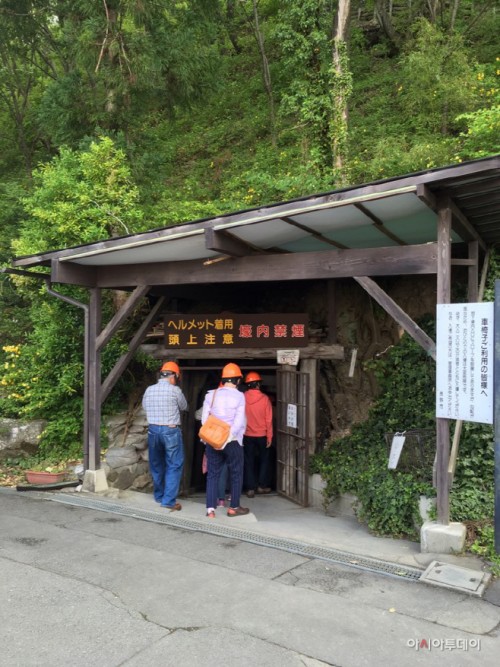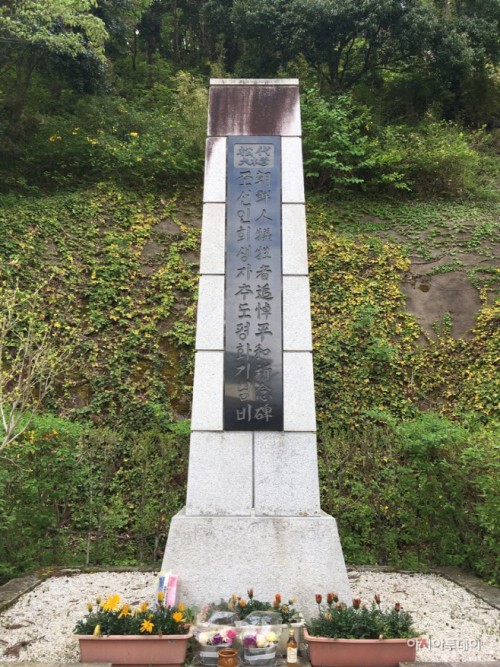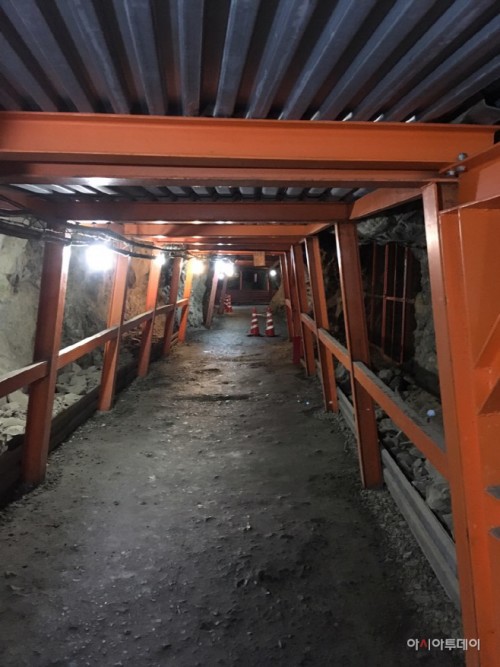 |
| The Matsushiro Underground Imperial Headquarters was an underground base made by Japan in order to relocate the Imperial Family and government organizations in November 1944, the end of the Pacific War. People are entering to the complex on Saturday./ Photographed by Um Soo-ah |
By Tokyo correspondent Um Soo-ah - Last Saturday, I visited the Matsushiro Underground Imperial Headquarters, where you can trace the sad history of Japan and Korea.
The Matsushiro Underground Imperial Headquarters is a large underground bunker complex built by Japan to safely transfer central organs of government of Imperial Japan at the end of the Pacific War.
It took about 40 minutes by bus from Nagano Station. It was a quiet village with shrines and old houses.
Although it's the largest underground base in Japan built at the end of the war, it's not a well known place, even to Japanese.
A number of elderly Japanese at the entrance to the complex were looking at the 'Peace Monument in Memory of the Korean Victims" built next to the entrance. Before Japan's dark and shameful history, the visitors looked serious.
The complex was a dense yet large labyrinth. It is about 6km long and has 20 tunnels in east-west direction. The cave is about 4 meters wide and 3 meters high. Construction was 80% completed at the end of the war.
Currently, only about 500 meters of the complex are open to the public for safety reasons. As you walk down, you can spot traces of holes and carts blown up by dynamites.
 |
| A monument to comfort the death of the Koreans is set up next to the entrance to the complex. It was built by a civic group, and is written as "'Peace Monument in Memory of the Korean Victims."/ Photographed by Um Soo-ah |
The most brutal parts were done by Korean laborers
Construction began in November, 1944 and the most harsh parts of constructing the complex were mostly done by Koreans.
Though it's not accurate, more than 7,000 Korean slaves were used to build the complex.
Until now, the number of victims of the complex construction is unknown. Some even gave testimony that as many as six people died in a single day during the construction. However, the burial site is still unknown.
As you walk down the road that leads to the basement, you will be able to feel deep sorrow of Koreans from Korean word "daegubu" (the name of Daegu area during the Joseon Dynasty) carved on the wall.
In terms of the number of Korean laborers, there are only four names remained for Korean senior officials. The board says that Koreans and Japanese were forced to work, but not all of them were forced.
Two years ago, Nagano City was criticized for putting a phrase in the board that there were various opinions such as "Not all of them were forced," in relation to the compulsory mobilization of the Koreans.
Comfort houses were set up around the shelters
Japan rented private houses around the shelter to use them as comfort houses with Korean comfort women servicing them.
Mr. K, who was forced to lend his building to the government, witnessed that four Korean women were brought in as comfort women by the fall of 1944, and they were young women aged around 20.
They allegedly comforted Japanese and Koreans who were in a relatively high position.
According to another testimony revealed by the executive committee, a comfort women with Japanese name "Kanemoto Junko" was from Gyeongnam and that she had been forced to come to Japan after hearing that she became a special supervisor from the people of the village administration.
According to another testimony revealed by the executive committee, a comfort women with Japanese name "Kanemoto Junko" was from Gyeongnam and that she had been forced to come to Japan after hearing that she became a special supervisor from the people of the village administration.
The private houses, which were used as comfort houses, were demolished in 1991. However, civic group "Another History Museum - Matsushiro Construction Execution Committee" (tentative name) is keeping some of the dismantled materials in the history museum. The civic group criticizes the Japanese government's responsibility for forcing mobilization of comfort women and demands that the materials about the comfort houses should be historically preserved.
 |
| The complex is about 4 meters wide, 3 meters high, and 6 kilometers long. It's like a maze. Only about 500 meters of the complex are open to the public today. |
The country for the emperor & The secret of the hidden underground complex
Why it had to be Nagano Matsushiro? It is surrounded by gentle mountains of 500 meters high, and it is said to have the right amount of rocks for building military facilities. Besides, it has an airstrip nearby. Many believe that these factors met the emperor's dignity. In addition, the fact that Shinshu, today's Nagano, sounds like "god's kingdom" also played a role.
In addition to the government basement, Japan built a separate underground space and a semi-basement concrete building only for the emperor. A bathhouse as well as an underground car for the emperor were developed.
According to the officials of the historical museum, the emperor's residence was completely forbidden to Korean laborers. Only young Japanese males who have no sexual experience were involved in constructing the site. This reflects how Japan, who calls its monarch an emperor, worked hard to maintain its regime.
#Matsushiro Underground Imperial Headquarters #Japan #Korean laborer #emperor #imperial
Copyright by Asiatoday
Most Read
-
1
-
2
-
3
-
4
-
5
-
6
-
7





















